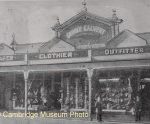Collections
Our Cambridge Collection has changing exhibitions about Cambridge. Much of our collection is in storage to ensure its preservation for future generations.
Calverts Building

Samuel Howard was advertising his business ‘Cambridge House’ in Victoria Street, Cambridge in 1893. He advertised goods such as Men’s Colonial Tweed Suits for thirty shillings. Beaver Mole Trousers, 8s 9d. Fern Boots made specially for the Waikato. Knitted socks from 11d. Ladies Corsets from 1s 9d. Single mattresses, 10s 6d. Lace curtains 3 yards long, 3s 11d. Calicoes 2s 6d. Inspection respectfully invited.
Robert Taylor Tudehope took over this business in 1901 and almost immediately replaced the original wooden building with new brick premises. He started business with one assistant and by 1905 had 8 staff and the quality and quantity of his stock was probably second to none in the Waikato. Tudehope used some innovative ideas for advertising – a limerick competition (which turned out to be illegal), in-store piano recitals, fashion parades.
He served two terms on the Cambridge Borough Council, was Vice Chair of the Cambridge Chamber of Commerce, and on the School and Library committees.
From the 1st January 1913 George Calvert took over the drapery and mercery business. He had worked for Smith & Caughey in Auckland and arrived in Cambridge with his wife and family.
Warren & Blechynden, architects of Hamilton were calling for tenders in 1923 for the erection and extension in brick to the Calverts building. In 1925 Calvert’s Chambers (the two storey part of the building) was built by Speight Pearce Nicoll & Davys, to accommodate a number of offices upstairs and two shops down stairs. In 1928 the window frontage and verandas were modernised for the sum of £1,200. It is not known exactly when the Lamson Cash Railway (Rapid Wire System) was installed.
Maurice Calvert (son of George) started with the business in 1933 and took over from his father in 1965. By now the Lamson Cash Railway System had become a tourist attraction. Many locals also formed fond memories of the ‘whizz bang’ as the carriages flew to the office in the middle of the building.
In July 1985 it was announced that Calverts had sold the building and fittings to the Post Office and the business was closing down. The Post Office gave many display items to the Cambridge Museum, and their plan was to demolish the building and rebuild. Fortunately, the building was later passed over by PostBank with their new restructuring and Vaughan Clements firstly leased the building and ran the Cambridge Community Market, then bought the building and redeveloped the site. The Victoria Street shop was remodelled into small shops and new shops were built on the back of the property in Empire Street. One of the long counters is in ‘Fran’s Cafe’.
Lamson Rapid Wire System
The Lamson Cash Railway System was bound for Tauranga Museum when spied by a Cambridge Historical member who picked it up for the Cambridge Museum in 1988. Vaughan Clements borrowed two satellites of the system and put them up in one of the redecorated shops. When it closed he removed the two satellites to his new venture ‘The Grapevine’ in Alpha Street. (These Cash Railway satellites have been returned to the Cambridge Museum.)
Quote from a pamphlet supplied by Lamson Engineering NZ Ltd in Auckland – “In [American] Civil War times, a phenomenon called ‘five-and-dimes’ were thriving all over the Eastern Seaboard. These stores were rapidly taking on the appearance of something larger – the department store. Cash required rapid movement from areas on the trading floor to the safer reaches of the store. Some of the stores were building up, not out, and this slowed the change-making process even more.
“William Stickney Lamson, and his wife, took charge of a family enterprise called Rachet Store. The retail business would soon shape up to become one of the first American ‘five-and-dimes’. The need in this business to move change lead to several innovations including wrapping change in a handkerchief and tossing it to the sales clerk in the front of the store.
“Innovations soon gave way to invention. Bill Lamson cut a croquet ball in half, hollowed out both sides and placed the change inside. Then, after rubber banding the halves together, would toss the ball from clerk to clerk. This led to the ‘carriers’ on a wire and using multiple-spring gadgets to move the balls at higher speeds.
“The wire conveyors or ‘cash carriers’ suited the smaller stores fine, but the ever expanding department stores in America required additional speed and more efficiency. Soon Bill Lamson was to jump on the pneumatic tube train in America.”
In 2003 two technicians from Lamson Engineering NZ Ltd in Auckland installed two Calvert’s cash railway satellites in the Cambridge Museum, so the ‘whizz bang’ can still be seen in Cambridge.
